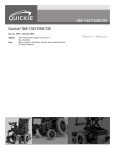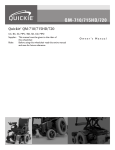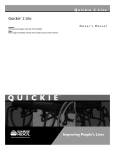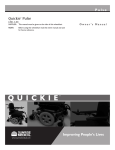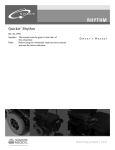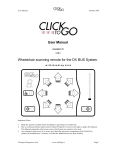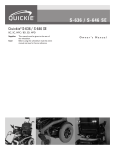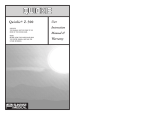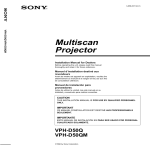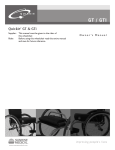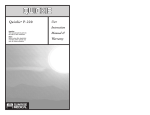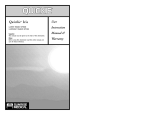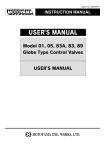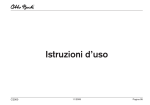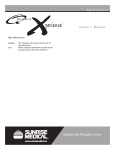Download Quickie® QM-710/715HD/720
Transcript
SECTION ENGLI SH QM-710/715HD/720 Quickie® QM-710/715HD/720 BC, SC, MPC / BD, SD, MPD Supplier: This manual must be given to the user of this wheelchair. User: Before using this wheelchair read this entire manual and save for future reference. O w n e r ’s M a n u a l Q M- 710/715HD/ 720 I. INTRODUCTION SUNRISE LISTENS USER WARNING Thank you for choosing a Quickie wheelchair. We want to hear your questions or comments about this manual, the safety and reliability of your chair, and the service you receive from your Sunrise supplier. Please feel free to write or call us at the address and telephone number below: WARNING Attention wheelchair users, do not operate this wheelchair without first reading the owner’s manual. If you do not understand the instructions and warnings of this owner’s manual please contact your dealer or qualified technician before operating this Quickie wheelchair. Failure to do so may result in damage and/or injury. Sunrise Medical Customer Service Department 2842 Business Park Ave Fresno, CA 93727 (800) 333-4000 DEALER/TECHNICIAN WARNING WARNING Attention dealers and qualified technicians, do not operate or service this wheelchair without first reading this owners manual. If you do not understand the instructions and warnings of this owners manual please contact the Quickie Technical Service Department before operating and/or servicing this Quickie wheelchair. Failure to do so may result in damage and/or injury. FOR ANSWERS TO YOUR QUESTIONS Your authorized supplier knows your wheelchair best, and can answer most of your questions about chair safety, use and maintenance. For future reference, fill in the following: Supplier: _______________________________________________________________ WARNING In addition, power wheelchairs may contain printed circuit boards. Careful attention should be given to the Printed Circuit Board Handling Techniques insert supplied with the chair. Address: _______________________________________________________________ ______________________________________________________________________ Telephone: _____________________________________________________________ Related Documents Listed below are additional documents which are referenced in this owners manual. Serial #: _________________________________________ Date/Purchased:_________ • • • • 118444 Rev. C 2 RNET Owners Manual RNET OBP Owners Manual RNET Omni Owners Manual QM-710/715HD/720 Service Manual QM- 710/715HD/720 II. TABLE OF CONTENTS I. II. III. IV. V. INTRODUCTION..........................................................................2 TABLE OF CONTENTS ...............................................................3 YOUR CHAIR AND ITS PARTS ................................................4 NOTICE– READ BEFORE USE...................................................5 EMI (ELECTROMAGNETIC INTERFERENCE).......................5 A. WHAT IS EMI? ............................................................................5 B. WHAT EFFECT CAN EMI HAVE?.........................................5 C.SOURCES OF EMI .....................................................................6 D. DISTANCE FROM THE SOURCE..........................................6 E. IMMUNITY LEVEL .....................................................................6 F. REPORT ALL SUSPECTED EMI INCIDENTS .....................6 G.EMI FROM CHAIR .....................................................................6 VI. GENERAL WARNINGS................................................................7 A. NOTICE TO USER AND ATTENDANTS.............................7 B. WEIGHT LIMIT ..........................................................................7 C.CONTROLLER SETTINGS......................................................7 D. SAFETY CHECK-LIST ...............................................................7 E. CHANGES & ADJUSTMENTS ................................................7 F. ACCESSORIES ............................................................................7 G.WHEN SEATED IN A PARKED WHEELCHAIR ................8 H.ENVIRONMENTAL CONDITIONS......................................8 I. TERRAIN ......................................................................................8 J. STREET USE ................................................................................8 K. MOTOR VEHICLE SAFETY......................................................8 L. CENTER OF BALANCE...........................................................8 M. TRANSFERS ................................................................................9 N.REACHING OR LEANING .....................................................9 O.DRESSING OR CHANGING CLOTHES.............................9 P. OBSTACLES.................................................................................9 Q.DRIVING IN REVERSE .............................................................9 R. RAMPS, SLOPES & SIDEHILLS..............................................10 S. TO REDUCE THE RISK OF A FALL, TIP-OVER OR LOSS OF CONTROL ....................................................10 T. RAMPS AT HOME & WORK ................................................10 U.WHEELCHAIR LIFTS..............................................................10 V. CURBS & SINGLE STEPS.......................................................10 W. STAIRS .......................................................................................10 X.ESCALATORS ...........................................................................10 VII. WARNINGS: COMPONENTS AND OPTIONS.................11 A. ARMRESTS.................................................................................11 B. BATTERIES.................................................................................11 C.CUSHIONS & SLING SEATS ................................................11 D. FASTENERS ...............................................................................11 E. FOOTRESTS..............................................................................11 F. MOTOR BRAKES.....................................................................11 G.ON/OFF SWITCH...................................................................11 H.PNEUMATIC TIRES .................................................................11 I. POSITIONING BELTS ............................................................11 J. PUSH HANDLES......................................................................12 K. SEATING SYSTEMS .................................................................12 L. UPHOLSTERY FABRIC...........................................................12 M. ASSIGNABLE CONTROLS...................................................12 N. POWER SEATING ..................................................................12 O.CG TILT POWER ACCESSORY ...........................................12 VIII. IX. X. XI. XII. 3 P. POWER RECLINE ...................................................................13 Q.POWER LEGREST ACCESSORY .........................................13 R. LIFT POWER ACCESSORY ...................................................13 S. TRANSIT OPTION AND USE .............................................13 SET-UP, ADJUSTMENT AND USE..........................................14 A. ADJUSTMENT NOTES...........................................................14 B. TOOLS YOU MIGHT NEED .................................................14 C.CHECK-OUT............................................................................14 D. BATTERY REMOVAL...............................................................14 E. FOLDING BACKREST ...........................................................15 F. SWING-AWAY FOOTRESTS................................................15 G ELEVATING LEGREST ............................................................15 H.CENTER MOUNT HANGER ADJUSTMENT ..................15 I. R-NET JOYSTICK ....................................................................16 J. JOYSTICK RETRACTABLE MOUNT ................................16 K. DUAL-POST HEIGHT-ADJUSTABLE ARMRESTS, FIXED HEIGHT STANDARD ..............................................17 L. SINGLE POST HEIGHT-ADJUSTABLE ARMRESTS .........17 M.SEAT DEPTH.............................................................................17 N.ASAP II SEATING ADJUSTMENT........................................18 O.SEAT PAN AND BACK SIZE ADJUSTMENTS .................18 P. MANUAL RECLINE OPERATION ......................................18 Q.POWER RECLINE, TILT & LIFT OPERATION .................18 OPERATING GUIDE...................................................................19 A. PERFORMANCE CONTROL SETTINGS..........................19 B. ON BOARD PROGRAMMER OR DTT OR RNET PC PROGRAMMER ............................................19 C.JOYSTICK STATIONARY.......................................................19 D. THERMAL ROLL-BACK .......................................................20 E. VR2 JOYSTICK ASSEMBLY ....................................................20 F. R-NET LED JOYSTICKS ..........................................................21 G. R-NET COLOR LCD SCREEN ...........................................22 H.BRAKE LEVER .........................................................................23 BATTERIES.....................................................................................24 A. INTRODUCTION ..................................................................24 B. BATTERY CHARGER ............................................................24 C.CONNECTING BATTERIES IN BATTERY COMPARTMENT .....................................................................25 D. CHARGING BATTERIES .......................................................25 E. DISPOSING OF BATTERIES .................................................25 MAINTENANCE...........................................................................26 A. NOTES ......................................................................................26 B. CLEANING .............................................................................26 C. STORAGE TIPS .......................................................................26 D. BATTERY MAINTENANCE ..................................................26 E. PNEUMATIC TIRES .................................................................26 F. TO REPAIR OR REPLACE A TIRE .......................................27 G.ORDERING PARTS ................................................................27 H.MAINTENANCE CHART......................................................27 G.FUSES .........................................................................................27 SUNRISE LIMITED WARRANTY.............................................28 118444 Rev. C Q M- 710/715HD/ 720 III. YOUR CHAIR AND ITS PARTS III. YOUR CHAIR AND ITS PARTS 1. Armrest 2. Joystick 7 1 2 8 3. Seat Pan 4. Front Hanger 5. Caster Tire 6. Foot Plate 10 14 3 7. Backrest 8. Push Handle 12 15 14 9. Free-wheel Release Lever 9 12. Base Frame 10. Seat Frame 11. Drive Wheels 13. Caster Fork 14. Transit Tie Down 4 15. Lift Module (optional) (not shown) 11 6 13 14 5 Models BC / BD SC (shown) / SD MPC / MPD QUICKIE QM-710 Weight (in lbs) BD BC complete chair: 310 w/o batteries: 220 SD SC 350 260 MPD MPC 375 285 Drive Wheels 14"x3" Mag: Std. airless insert Option - pneumatic, Black pneumatic Joystick Standard – VR2 (right-hand or left-hand mount) Option - VR2 w/actuator control (SC only) Option - RNET– LED/Color Batteries (2 deep cycle batteries required to operate chair) Standard - Group 24 Option - Group 22 Option - Group 34 Battery Charger Off board 8 AMP 118444 Rev. C Shroud Colors Red, Black, Blue, Copper, Silver, White, Yellow, Pink, Green, Blue Opal, Purple, Carbon Fiber, and Matte Black. Seats, Upholstery and Style StandardBC, SC, MPC: A.S.A.P. II Seat Frame Sizes: 12" - 22" wide, 12" - 22" deep MPC: 14" - 22" wide, 16" - 22" deep Power Recline Footrest: Standard- Swing away footrests with heel loops Option- Foot platform, Manual elevating legrests, Power Articulating Legrest (ALR), Power Center Mount, Center Mount Backrest SC & BC: Standard Canes Angle Adjustable Option- 8° Bend, Semi Recline, Folding MPC: Recline 4 Casters (rear/front) Standard- 6” solid Armrest SC & BC: Standard- 14" Cantilever, height adjustable 14" arm pad Option- Locking, two-point arm, Dual post Arm, Single Post arm MPC: Reclining/Otto Bock Suspension Standard- all wheel All features may not be available with some chair setups or in conjunction with another chair feature. Please consult your supplier for more information. Your authorized supplier can also provide you with more information on accessories. QM- 710/715HD/720 IV. NOTICE– READ BEFORE USE A. CHOOSE THE RIGHT CHAIR & SAFETY OPTIONS 2. VI — GENERAL WARNINGS Here you will find a safety checklist and a summary of risks you need to be aware of before you ride this chair. Sunrise provides a choice of many power wheelchair styles, sizes and adjustments to meet the needs of the user. However, final selection of a wheelchair rests solely with you and your health care professional. Choosing the best chair for you depends on such things as: 3. VII — WARNINGS — COMPONENTS & OPTIONS Here you will learn about your chair. Consult your supplier and your health care professional to help you choose the best set-up and options for your safety. 1. Your size, disability, strength, balance and coordination. 2. Your intended use, and your level of activity. 3. The types of hazards you must overcome in daily use (in areas where you are likely to use your chair). 4. The need for options for your safety and comfort (such as positioning belts or special seat systems). 4. XI — BATTERIES Here you will learn about battery and charger safety, and how to avoid injury. Q-NOTE– Where they apply, you will also find “Warnings” in other sections of this Manual. B. ADJUST CHAIR TO YOUR ABILITY Throughout this owner’s manual and on the wheelchair you will see the icons listed below to identify warnings and potential hazards. It is important to read and understand all of them and understand them. You need to work with your doctor, nurse or therapist, and your supplier, to fit this chair and adjust the controller settings for your level of function and ability. WARNING! C. REVIEW THIS MANUAL OFTEN Before using this chair you, and each person who may assist you, should read this entire Manual and make sure to follow all instructions. Review the warnings often, until they are second nature to you. Q-NOTE: Q-Notes are informative statements to help further explain actions, warnings or product detail. ESD: Electrostatic Discharge can damage printed circuit boards unless handled correctly. When the ESD symbol is used in your owner’s manual, be careful not to touch the areas that are being referred to. D. WARNINGS The word “WARNING” refers to a hazard or unsafe practice that may cause severe injury or death to you or to other persons. The “Warnings” are in four main sections, as follows: 1. V — EMI Here you will learn about electromagnetic interference and how it can affect your chair. These warnings must be followed, failure to do so may cause personal injury or may damage the wheelchair. V. EMI (ELECTROMAGNETIC INTERFERENCE) 3. Powered wheelchairs may be susceptible to electromagnetic interference (EMI) emitted from sources such as radio stations, TV stations, amateur radio (HAM) transmitters, two way radios, and cellular phones. 4. EMI can also be produced by conducted sources or electrostatic discharge (ESD). WARNING Heed all warnings to reduce the risk of unintended brake release or chair movement: 1. Beware of the danger from hand-held transceivers. Never turn on or use a hand-held transceiver while power to your chair is on. Use extra care if you believe that such a device may be in use near your chair. 2. Be aware of nearby radio or TV stations, and avoid coming close to them. 3. If unintended movement occurs, turn your chair off as soon as it is safe to do so. B. WHAT EFFECT CAN EMI HAVE? WARNING 1. EMI can cause your chair, without warning, to: • Release its brakes • Move by itself • Move in unintended directions If any of these occur, it could result in severe injury to you or others. 2. EMI can damage the control system of your chair. This could create a safety hazard, and lead to costly repairs. A. WHAT IS EMI? WARNING 1. EMI means: electromagnetic (EM) interference (I). EMI comes from radio wave sources such as radio transmitters and transceivers. (A “transceiver” is a device that both sends and receives radio wave signals). 2. There are a number of sources of intense EMI in your daily environment. Some of these are obvious and easy to avoid. Others are not, and you may not be able to avoid them. 5 118444 Rev. C Q M- 710/715HD/ 720 V. C. SOURCES OF EMI 4. The following specialty input device options, that can be used with this powerchair have an unknown effect on their immunity level to different types of EMI. They have not been specifically tested with the QM-710/715HD/720 and RNET control system: WARNING The sources of EMI fall into three broad types: 1. Hand-Held Transceivers: The antenna is usually mounted directly on the unit. These include: • Citizens band (CB) radios • “Walkie-talkies” • Security, fire and police radios • Cellular phones • Lap-top computers with phone or fax • Other personal communication devices • • • • • Q-NOTE– These devices can transmit signals while they are on, even if not in use. • • • • 2. Medium-Range Mobile Transceivers: These include two-way radios used in police cars, fire trucks, ambulances and taxi cabs. The antenna is usually mounted on the outside of the vehicle. 3. Long-Range Transceivers: These include commercial radio and TV broadcast antenna towers and amateur (HAM) radios. • • • • • • • • • • • • Star Board Proximity Head Array Wafer Board Zero Touch Switch Penta Switch 4-Zero Touch Switch Plate Switch 5-Zero Touch Switch Soft Switch Disc Switch Grasp Switch Wobble Switch WARNING Individuals with physical limitations requiring the use of a specialty control input device known not to be immune to 20V/m, or not known, should exercise extra care around known sources of EMI. NOTE– The following are not likely to cause EMI problems: Laptop computers (without phone or fax), Cordless phones, TV sets or AM/FM radios, CD or tape players. WARNING There is no way to know the effect on EMI if you add accessories or modify this chair. Any change to your chair may increase the risk of EMI. Parts not specifically tested or parts from other suppliers have unknown EMI properties. D. DISTANCE FROM THE SOURCE WARNING Electro-magnetic energy rapidly becomes more intense as you get closer to the source. For this reason, EMI from hand-held devices is of special concern. (See C.1 above) A person using one of these devices can bring high levels of EM energy very close to your chair without you knowing it. F. REPORT ALL SUSPECTED EMI INCIDENTS WARNING You should promptly report any unintended movement or brake release. Be sure to indicate whether there was a radio wave source near your chair at the time. Contact: E. IMMUNITY LEVEL WARNING 1. The level of EM is measured in volts per meter (V/m). Every power wheelchair can resist EMI up to a certain level. This is called its “immunity level”. 2. The higher the immunity level, the less the risk of EMI. It is believed that a 20 V/m immunity level will protect the power wheelchair user from the more common sources of radio waves. 3. The configuration tested and found to be immune to at least 20 V/m is: Quickie QM-710 power wheelchair with a righthand mounted RNET remote joystick system, 18" seat width, 18" seat depth, dual post height adjustable armrests, fixed tapered legrests with one piece solid footplate, and Gp 24 gel cell batteries. 118444 Rev. C Breath Control Proportional Head Control Tri-Switch Head Array Proportional MiniJoystick/Chin Control Heavy Duty Switched Joystick Buddy Button Treadle Switch Micro Light Ribbon Switch Sunrise Medical, Customer Service Department at (800) 333-4000. G. EMI FROM CHAIR WARNING The chair itself can disturb the performance of electromagnetic fields such as emitted by alarm systems of shops. 6 QM- 710/715HD/720 VI. GENERAL WARNINGS 4. Propel this chair by the push handles only. They provide secure points for you to hold the rear of the chair to prevent a fall or tip-over. 5. Check to make sure push handle grips will not rotate or slip off. WARNING Heed all warnings in this section. If you fail to do so a fall, tip-over or loss of control may occur and cause severe injury to you or others. B. WEIGHT LIMIT A. NOTICE TO USER AND ATTENDANTS WARNING 1. The user plus items carried should never exceed the total weight capacity identified on your chair. 2. Never use this chair for weight training if the total weight (user plus additional weights) exceeds weight capacity. 3. Exceeding the weight limit is likely to damage the seat, frame, or fasteners, and may cause severe injury to you or others from chair failure. 4. Exceeding the weight limit will void the warranty. WARNING User: 1. Before using this chair, you should be trained in its safe use by your health care professional. 2. Every wheelchair is different. Take the time to learn the feel of this chair before you begin riding. 3. Be aware that you must develop your own methods for the safe use of this chair that are best suited to your level of function and ability. 4. Have someone help you practice bending, reaching and transfers until you learn how to do them safely. 5. Never try a new maneuver on your own unless you are sure it is safe. 6. Get to know the areas where you plan to use your chair. Look for hazards and learn how to avoid them. 7. Always wear a positioning strap. 8. Do not use a wheelchair if the joystick does not spring back to the neutral position. 9. Do not use your wheelchair if the joystick boot is ripped or damaged. 10. Do not try to tip this wheelchair without an attendant present. C. CONTROLLER SETTINGS WARNING Be aware that you may need to adjust the controller settings of your chair. 1. Check and adjust the settings every six to twelve months. 2. Consult your supplier to adjust the control settings immediately if you notice any change in your ability to: • Control the joystick • Hold your torso erect • Avoid running into objects. D. SAFETY CHECK-LIST User and Attendants: 1. When transferring the user in or out of the wheelchair never use the footplate as a platform. 2. Do not lift this wheelchair by any parts that are removable, doing so may result in damage to the wheelchair or injury to the user. 3. Never try to stop or slow this wheelchair with the wheel locks (if applicable). Wheel locks are designed to prevent the chair from moving when stopped. They are not brakes. 4. Always keep your hands and body parts clear of moving parts to help prevent injuries. WARNING Before each use of this chair: 1. Make sure the chair operates smoothly. Check for noise, vibration, or a change in ease of use. (They may indicate low tire pressure, loose fasteners, or damage to your chair). • If you detect a problem, make sure to repair or adjust the chair. Your supplier can help you find and correct the problem. 2. Make sure batteries are charged. Green lights on charge indicator will light up when charge is full. Yellow lights indicate battery charge level is getting low. Red lights indicate batteries are in immediate need of charging. Attendants: WARNING E. CHANGES & ADJUSTMENTS Make sure you heed all warnings and follow all instructions in each section of this manual. Warnings that apply to the user also apply to you. WARNING Never use non-Quickie parts to replace Quickie provided parts or make changes to your chair unless authorized by Sunrise. (Doing so will void the warranty and may create a safety hazard.) 1. Do not stand or sit on any portion of this wheelchair. 2. You need to work with the user, and the user’s doctor, nurse or therapist, to develop safe methods best suited to your abilities and those of the user. 3. To manually push the chair you must release the motor brakes. • Do not engage or disengage motor brakes unless power to the chair is off. • Make sure you have full control over the chair when you release the motor brakes. When you do so the chair will not have brakes. • Make sure the chair is on level ground before you release the motor brakes. F. ACCESSORIES WARNING Accessories designed by manufacturers other than Sunrise, not available through Sunrise order process have not been tested or approved for use by Sunrise. 1. If you modify or adjust this chair it may increase the risk of a fall or tip-over. 2. Modifications unauthorized by Sunrise constitutes remanufacturing of the wheelchair. This voids the warranty. The user then assumes all future liability for the wheelchair. 7 118444 Rev. C Q M- 710/715HD/ 720 VI. G. WHEN SEATED IN A PARKED WHEELCHAIR J. STREET USE WARNING WARNING This product is not intended for street use. Avoid streets whenever possible. 1. Always turn off all power to your chair when you are parked, even for a moment. This will prevent: • Accidental movement from contact with the joystick by you or others. • Unintended brake release or movement from EMI sources. (See Section V) 2. Make sure that persons who help you (for example, store clerks) are aware of the joystick and do not touch it. If they do, your chair may move suddenly when you do not expect it. 1. Do not operate this wheelchair on any roadways that do not allow non-motor vehicle traffic. 2. When visibility is limited by either darkness or weather conditions, do not operate the chair on any roadways. 3. It may be hard for drivers to see you. Make eye contact with drivers before you proceed. When in doubt, yield until you are sure it is safe. WARNING H. ENVIRONMENTAL CONDITIONS K. MOTOR VEHICLE SAFETY WARNING Identify whether your chair has been manufactured with the Transit Option installed. Your chair is not designed for use in a heavy rain storm, or in snowy or icy conditions. 1. Contact with water or excessive moisture can cause an electrical malfunction. The frame, motors and other chair parts are not water-tight and may rust or corrode from the inside. To avoid a chair failure: • Minimize exposure of your chair to rain or very wet conditions. • Never take your chair into a shower, tub, pool or sauna. • Do not use your chair in fresh or salt water (such as at the edge of a stream, lake, or ocean). • Make sure battery cover is secure. • Replace joystick boot if it becomes torn or cracked. • Make sure all electrical connections are secure. • Dry the chair as soon as you can if it gets wet, or if you use water to clean it. 2. Proceed slowly and use extra care if you must operate your chair on a wet or slick surface. • When in doubt, have someone help you. • Stop if one or both main wheels lose traction. If this occurs, you may lose control of your chair or fall. • Never operate your chair on a slope or ramp if there is snow, ice, water or oil film present. 3. When not in use, keep your chair in a clean, dry place. If your chair is not equipped with the Transit Option: The wheelchair does not meet federal standards for seating while travelling in a motor vehicle. 1. NEVER let anyone sit in this chair while in a moving vehicle. 2. ALWAYS secure the rider with OEM motor vehicle restraints. In an accident or sudden stop the rider may be thrown from the chair. Wheelchair seat belts will not prevent this, and further injury may result from the belts or straps. 3. NEVER transport this chair in the front seat of a vehicle. It may shift and interfere with the driver. 4. ALWAYS secure this chair so that it cannot roll or shift. 5. Do not use any chair that has been involved in a motor vehicle accident. It may have changed the structure of the chair, and damaged, or broken components. This could lead to a risk of injury or damage to your chair. If the wheelchair has been involved in an accident, discontinue use and contact your supplier for a thourough inspection. If your chair is equipped with the Transit Option: See section VIIS: “Transit Option and use”. L. CENTER OF BALANCE WARNING WARNING Extra caution should be used when employing the disc switch or the proximity head array as control devices. These two devices are susceptible to malfunction when wet. The point where this chair will tip forward, back, or to the side depends on its center of balance and stability. The Center Of Balance Is Affected By: 1. The seat height and seat angle. 2. A change in your body position, posture or weight distribution. 3. Using this chair on a ramp or slope. 4. The use of a back pack or other options, and the amount of added weight. 5. Drive wheel positioning. I. TERRAIN WARNING 1. This chair will perform at optimum on firm, even surfaces such as concrete, asphalt and indoor flooring. 2. Although equipped with suspension, the performance can be substantially reduced on uneven surfaces and rough terrain. 3. Do not operate the chair on sand, loose gravel or soil. Doing so may damage wheels, bearings, axles, motors or loosen fasteners. 118444 Rev. C To Reduce The Risk Of A Fall Or Tip-Over: Whenever a condition exists that may change the center of balance, reduce speed, proceed cautiously, and when in doubt, always have someone help you. 8 QM- 710/715HD/720 VI. M. TRANSFERS WARNING WARNING IF YOU MUST REACH OR LEAN, DO SO AT YOUR OWN RISK. It is dangerous to transfer on your own. It requires good balance and agility. Be aware that there is a point during every transfer when the wheelchair seat is not below you. To prevent a fall: 1. Always turn off power before you transfer to or from your chair. If you fail to do so you may touch the joystick and cause your chair to move when you do not expect it. 2. Make sure motor brakes are engaged. This keeps the chair from moving when you transfer. 3. Work with your health care professional to learn safe methods. • Learn how to position your body and how to support yourself during a transfer. • Have someone help you until you are sure you can do a safe transfer on your own. 4. Move your chair as close as you can to the seat you are transferring to. If possible, use a transfer board. 5. Rotate the front casters until they are as far forward as possible. 6. Be careful of the footrests. If you can, remove or swing them out of the way. • Never stand on footrests when you transfer. Doing so may damage them or cause your chair to tip. • Make sure your feet do not “hang up” or get caught in the space between the footrests. 7. Make sure armrests do not interfere. 8. Transfer as far back onto the seat surface as you can. This will reduce the risk that you will miss the seat or fall. Remember to: 1. Move your chair as close as you can to the object you wish to reach. 2. Rotate the front casters until they are as far forward as possible. This makes the chair more stable. Q-NOTE– To do this: Move your chair past the object you want to reach, then back up alongside it. Backing up will rotate the casters forward. 3. Turn off all power to your chair. If you fail to do so, you may touch the joystick and cause your chair to move when you do not expect it. O. DRESSING OR CHANGING CLOTHES WARNING Be aware that your weight will shift if you dress or change clothes while seated in this chair. To make the chair more stable, rotate the front casters until they are forward. P. OBSTACLES WARNING Riding over curbs or obstacles can cause tipping and serious bodily harm. If you have any doubt that you can safely cross any curb or obstacle, ALWAYS ASK FOR HELP. Be aware of your riding skills and personal limitations. Develop new skills only with the help of a companion. N. REACHING OR LEANING 1. Be aware that thresholds are very dangerous. (Even a small change in height may stop a caster wheel and cause your chair to tip). You may need to: • Remove or cover threshold strips between rooms. • Install a ramp at entry or exit doors. 2. Keep your eyes moving when you ride; scan the area well ahead of your chair. 3. Make sure the floor areas where you use this chair are level and free of obstacles. WARNING Reaching or leaning affects the center of balance of your chair. If done improperly, a fall or tip-over is likely. When in doubt, ask for help or use a device to extend your reach. To Reduce the Risk of injury and/or Damage to the Chair: 1. Never reach or lean if you must shift your weight sideways or rise up off the seat. 2. Never reach or lean if you must move forward in your seat to do so. Always keep your buttocks in contact with the backrest. 3. Never reach with both hands (you may not be able to catch yourself to prevent a fall if you lose your balance). 4. Never try to pick up an object from the floor by reaching down between your knees. 5. Never put pressure on the footrests while reaching. 6. Never reach or lean over the top of the seat back. This may damage the backrest and cause you to fall. Q. DRIVING IN REVERSE WARNING Use extra care when you drive your chair in reverse. You may lose control or fall if one of the rear wheels hits an object. 1. Operate your chair slowly and at an even speed. 2. Stop often and check to make sure your path is clear of obstacles. 9 118444 Rev. C Q M- 710/715HD/ 720 VI. R. RAMPS, SLOPES & SIDEHILLS WARNING chair from going over the edge. 2. Slope must not be steeper than one inch in height for every one foot of slope length (approximately 10º). 3. Ramp surface must be even, and have a non-skid surface. 4. You may need to add a section at the top or bottom to avoid a lip or drop-off. 5. Ramp must be sturdy. Add bracing if needed, so ramp does not “bow” when you ride on it. The center of balance of your chair changes when you are on a slope. Q-NOTE– “Slope” includes a ramp or sidehill. Your chair is less stable when it is at an angle. Never use this chair on a slope unless your are sure it is safe. When in doubt, have someone help you. U. WHEELCHAIR LIFTS Beware Of: 1. Steep slopes. Do Not use this chair on a slope steeper than 10%. (A 10% slope means: One foot in elevation for every ten feet of slope length). 2. Wet or slippery surfaces (such as when ice, snow, water or oil film is present). A loss of traction may cause a fall or tipover. 3. A change in grade on a slope (or a lip, bump or depression). These may cause a fall or tip-over. 4. A drop-off at the bottom of a slope. (A drop-off of as small as 3/4 inch (19 mm) can stop a front caster and cause the chair to tip forward). WARNING Wheelchair lifts are used in vans, buses, and buildings to help you move from one level to another. 1. Always turn off all power to your chair when you are on a lift. If you fail to do so, you may touch the joystick by accident and cause your chair to drive off the platform. (Be aware that a “roll-stop” at the end of the platform may not prevent this). 2. Make sure there is not a lip or drop-off at the top or bottom of the platform. These may cause a fall or tip-over. When in doubt, have someone help you. 3. Always position the user securely in the chair to help prevent falls while on a lift. 4. Avoid moving forward if a wheel is “hung up” on the lip of the ramp. Backup, reposition the caster for a more direct approach. And slowly try again. S. TO REDUCE THE RISK OF A FALL, TIP-OVER OR LOSS OF CONTROL WARNING 1. Never use your chair on a slope unless you are sure you can do so without losing traction. 2. Always go as straight up and as straight down as you can. • Do not “cut the corner” on a slope or ramp. • Do not turn or change direction on a slope. 3. Always stay in the center of the ramp. Make sure ramp is wide enough that you are not at risk that a wheel may roll off the side. 4. Keep your chair moving at a slow, steady speed. Keep control over the chair at all times. • On a descent, do not let your chair accelerate beyond its normal speed. • If the chair picks up speed, center the joystick to slow down or stop. • If you stop, re-start slowly. V. CURBS & SINGLE STEPS WARNING 1. It is recommended to climb and/or descend a curb, single step, or other obstacle that a ramp or curb cutout is always used. 2. If you must climb or descend a curb, single step, or other obstacle that is greater than 2.5", it is recommended to have a person assist you in doing so. 3. In no case should you try to climb a curb, single step, or other obstacle greater than 4" high. 4. If you must climb or descend a curb or step alone do so at your own risk using extreme care and follow the following procedure: • Proceed slowly, at a steady speed • Go as straight up or down as you can over the obstacle. Never turn when trying to climb or descend and obstacle, doing so may result in a fall or tip-over. 5. Failure to follow the above procedures may cause: • A Fall or Tip Over • Damage to the frame, wheels, axles or other parts, or loose fasteners. T. RAMPS AT HOME & WORK WARNING Before driving on a ramp, survey the condition of the ramp. On slippery ramps traction may be reduced causing your wheelchair to slide. W. STAIRS WARNING WARNING Make sure ramps meet all Building Codes for your area. 1. For your safety, have a licensed contractor build or remodel ramp to meet all standards. Q-NOTE– The proper design will vary, depending on 2. such things as: the length and height of the ramp; the need for an intermediate platform; landing size; doors, and the direction of swing, and; whether the ramp includes a turn or angle. Never use this chair to go up or down stairs, even with an attendant. Doing so is likely to cause a fall or tip-over. X. ESCALATORS WARNING Never take this chair on an escalator, even with an attendant. Doing so is likely to cause a fall or tip-over. At A Minimum: 1. Open sides of ramp must have side rails to prevent your 118444 Rev. C 10 QM- 710/715HD/720 VII. WARNINGS: COMPONENTS AND OPTIONS 3. The footrest should always be in the down position when operating the chair. 4. Never lift this chair by the footrests. Footrests detach and will not bear the weight of this chair. Lift this chair only by non-detachable parts of the main frame. WARNING Note: If you use parts or make changes not authorized by Sunrise it may create a safety hazard and will void the Warranty. A. ARMRESTS F. MOTOR BRAKES WARNING WARNING 1. Armrests will not bear the weight of this chair. 2. Never lift this chair by its armrests. They may come loose or break. 1. Do not engage or disengage motor brakes unless power to the chair is off. 2. Be aware that the chair will not have brakes when motor brakes are in the free-wheel position. 3. Make sure that the person pushing the chair has full control when motor brakes are disengaged. 4. Make sure that the chair is on level ground when motor brakes are disengaged. B. BATTERIES WARNING 1. Always wear rubber gloves and safety glasses when you handle batteries. 2. Never smoke or hold an open flame near batteries. They are a known explosion hazard. 3. Only deep cycle sealed case construction batteries should be used in this device. 4. To prevent an acid spill, always keep batteries upright (wet cell batteries). 5. Read all of section X. Batteries before attempting to change, or charge batteries. G. ON/OFF SWITCH WARNING 1. Never use the ON/OFF switch to stop the chair except in an emergency. This will result in an abrupt stop, and may cause you to fall. 2. To slow your chair to a stop, return the joystick to neutral. H. PNEUMATIC TIRES C. CUSHIONS & SLING SEATS WARNING WARNING Proper inflation extends the life of your tires and makes your chair easier to use. 1. Standard foam cushions and other body supports are not designed for the relief of pressure. 2. If you suffer from pressure sores, or if you are at risk that they will occur, you may need a special seat system or a device to control your posture. • Consult your doctor, nurse or therapist to find out if you need such a device for your well-being. 1. Do not use this chair if any of the tires are under- or overinflated. Check weekly for proper inflation level, as listed on the tire sidewall. 2. Low pressure in a tire may cause the chair to veer to one side and result in a loss of control. 3. An over-inflated tire may burst. 4. Never use a gas station air pump to inflate a tire. Such pumps provide air at high volume, and could cause the tire to burst. To prevent tire damage: • Use a hand pump (or low volume air pump) to inflate tires. • Use a tire gauge to check pressure. 5. Driving over sharp objects may cause damage to pneumatic tires and tubes. D. FASTENERS WARNING Many of the screws, bolts and nuts on this chair are special highstrength fasteners. Use of improper fasteners may cause your chair to fail. 1. Only use fasteners provided by Sunrise. 2. If fasteners become loose, tighten them immediately. 3. Over- or under-tightened fasteners may fail or cause damage to chair parts. I. POSITIONING BELTS (OPTIONAL) WARNING Use a positioning belt only to help support your posture. Improper use of such belts may cause severe injury or death. E. FOOTRESTS WARNING 1. Make sure you are not at risk to slide down in the wheelchair seat. If this occurs, you may suffer chest compression or suffocate due to pressure from the belt. 2. A pelvic wedge or a similar device can help keep you from sliding down in the seat. Consult your health care professional to find out if you need such a device. 3. The belt must be snug, but must not be so tight that it interferes with breathing. You should be able to slide your open hand, flat, between the belt and your stomach. 4. Make sure you can easily remove the belt in an emergency. 1. At the lowest point, footrests should be at least 2 1/2 inches (65 mm) off the ground. If set too LOW, they may “hang up” on obstacles you can expect to find in normal use. This may cause the chair to stop suddenly and tip forward. 2. To avoid a trip or fall when you transfer: • Make sure your feet do not “hang up” or get caught in the space between the footrests. • Avoid putting weight on the footrests, as the chair may tip forward. • Remove or swing the footrests out of the way, if possible. 11 118444 Rev. C Q M- 710/715HD/ 720 VII. N. POWER SEATING WARNING WARNING Never use a positioning belt: 1. Operation • While driving this wheelchair in the reclined, elevated, or tilted position use caution. • Do Not attempt to operate any power seating option while positioned on an incline. • Do Not attempt to operate any power seating option while this wheelchair is in motion. • Do not attempt to operate the lift or tilt power seating options around children. • Through programming it is possible to reverse the direction of all powered seating functions, ensure you know which direction your seat is going to move before operating. • In place of a motor vehicle seat belt. In an accident or sudden stop you may be thrown from the chair. A positioning belt will not prevent this, and further injury may result from the belt. • As a restraint. A restraint requires a doctor’s order. • On a user who is comatose or agitated. J. PUSH HANDLES WARNING 1. Push handles provide secure points for an attendant to propel and control the chair. This helps to prevent a fall or tipover. 2. Check to make sure push handle grips will not rotate or slip off. 2. Reduced Speed Driving (Creep) This power chair is designed to automatically reduce the maximum driving speed to a creep mode when certain power seating limits are reached. K. SEATING SYSTEMS 3. Pinch points Pinch points may occur when operating the powered seating options on this chair. Ensure all hands and body parts are clear of all power seating components that may result in pinch points before operating them. WARNING 1. Use of a seating system not approved by Sunrise may alter the center of balance of this chair. This may cause a fall or tip-over. 2. Never change the seating system of your chair unless you consult your supplier first. 3. Never raise your seating system to a height of more than 22" (measuring from the front of the seat pan to the floor) with all actators in their home position. 4. Tilting Power Base with Push Handles Do not attempt to tilt power wheelchairs by pulling down on the push handles. Power wheelchairs have heavy bases. As such, attempting to tilt a power wheelchair to traverse obstacles can damage components in the seating system and/or modular actuators. L. UPHOLSTERY FABRIC 5. Remain Clear During Power Accessory Operation Please stay clear of any powered actuator while the component is in motion. Sunrise power mechanisms move over large ranges of travel. Users should be aware of their surroundings while components are in motion. WARNING 1. Replace worn or torn fabric of seat sling and seat back as soon as you can. If you fail to do so, the seat may fail and cause you to fall. Worn fabrics may increase the potential for a fire hazard. 2. Sling fabric will deteriorate with age and use. Look for fraying, thin spots, or stretching of fabric at rivet holes. Replace fabric as required. 3. Be aware that washing may reduce flame retardation of the fabric. 6. Maximum User Weight Do not exceed the weight capacity for your specific chair/seating system configuration. Doing so could result in premature failure or injury. 7. Latch Mode While operating any power seating function in latched mode use caution. In latch mode, powered seating will not stop until a reverse command is performed or the end of travel is met. M. ASSIGNABLE CONTROLS WARNING O. CG TILT POWER ACCESSORY It is possible to assign a function to an input control (buttons, jacks) of your wheelchair . If controls have been assigned to perform a dual or alternate function ensure you know what each control operates. Please contact your dealer or the Quickie Technical Service Department if you do not receive this information. Failure to do so may result in damage and/or injury. 118444 Rev. C WARNING The powered CG Tilt accessory for this chair has a maximum user weight capacity of up to 300 lbs (400 lbs for the QM-715HD). Never exceed this capacity while operating the powered actuator. 12 QM- 710/715HD/720 VII. P. POWER RECLINE WARNING WARNING 1. Use only Wheelchair Tie-down and Occupant Restraint Systems (WTORS) which meet the requirements of SAE J2249 Recommended Practice– Wheelchair Tie-down and Occupant Restraint Systems For Use in Motor Vehicles. Do not use WTORS designed to rely on the wheelchair structure to transfer occupant restraint loads to the vehicle. 2. The wheelchair has been dynamically tested in a forward-facing mode for a 30 mph frontal impact test. The wheelchair must be forward-facing during transport. 3. In order to reduce the potential of unjury to vehicle occupants, wheelchair-mounted accessories, such as trays and respiratory equipment, should be removed and secured separately. 4. Postural supports and positioning devices should not be relied on for occupant restraint. 5. Do not alter or substitute wheelchair frame parts, components or seating. 6. Sudden stops or impacts can structurally damage your chair. Chairs involved in such incidents should be replaced. Pinch Point Avoid putting hands or fingers near the power recline mechanism while in operation. Weight Capacity The maximum user weight capacity for the power recline is up to 350 lbs. Exceeding this weight capacity could lead to injury and/or permanent damage to the equipment. Q. POWER LEGREST ACCESSORY The power legrest accessory has a maximum user weight capacity of up to 300 lbs (400 lbs for the QM-715HD) depending on your chair configuration. Never exceed this capacity while operating the powered actuator. R. LIFT & LIFT/TILT COMBO WARNING The powered lift and/or lift/tilt modular accessory for this chair has a maximum user weight capacity of up to 300 lbs. Never exceed this capacity while operating the powered actuator. S. TRANSIT OPTION AND USE Refer also to sections VI-K: “Motor Vehicle Safety” and VIII-K: “Transit Option” for additional transit option and motor vehicle warnings. Transit use does not apply to the QM-715HD. WARNING 1. If possible and feasible, the rider should transfer to the original Equipment Manufacturer vehicle seat and use the vehicle restraint. 2. If the wheelchair is used for transport, it must be used in a forward-facing seating poition. 3. The rider must not weigh more than 300 lbs. 4. Use only with Wheelchair Tie-down and Occupant Restraint Systems (WTORS) that have been installed in accordance with the manufacturer’s instructions and SAE J2249. 5. Attach WTORS to securement points in accordance with the manufacturer’s instructions and SAE J2249. 6. Attach occupant restraints in accordance with the manufacturer’s instructions and SAE J2249. 7. Ensure hip guides are mounted to lock in place. 13 118444 Rev. C Q M- 710/715HD/ 720 VIII. SET-UP, ADJUSTMENT AND USE A. ADJUSTMENT NOTES D. BATTERY REMOVAL 1. Work Surface For Set-Up: Use a flat surface, such as a table, to assemble, adjust and check your chair. This makes the steps easier and helps ensure a correct set-up. 1 2 3 4 To remove the batteries for transporting or servicing: Remove Batteries a. Remove the two knobs (A) securing the seat. Tilt the entire seat back until it rests on the stop. b. Remove the shroud cover by lifting up on it as shown. c. Disconnect both battery harnesses (red & black connectors). d. Lift the battery from the compartment via the battery carrying straps. 2. Fasteners: • Many of the screws and bolts on this chair are special highstrength fasteners and may have special coatings. • Many nuts are of the Nylock type. They have a plastic insert to help prevent loosening. • Only use screws, bolts and nuts provided by Sunrise. WARNING WARNING Batteries may weigh up to 55 lbs. (25 kg). Care must be taken to avoid injury when lifting. 1. Use of improper fasteners may cause the chair to fail. 2. Over- or under-tightened fasteners may fail or cause damage to chair parts. 3. If bolts or screws become loose, tighten them as soon as you can. Loose bolts or screws can cause damage to other chair parts causing them to fail. 1 3. Washers & Spacers: • Note the position of washers and spacers before disassembly. • To avoid damage to the frame, replace all washers and spacers when you reassemble parts. A 4. Torque Settings: • A torque setting is the optimal tightening for a particular fastener. Use a torque wrench that measures inch-pounds to secure screws, nuts and bolts on this chair. 2 B. TOOLS YOU MIGHT NEED 1. Basic Tool Kit: To set-up, adjust and maintain your chair you may need the following tools: • Combined Phillips and flat screw driver • Standard metric wrenches from 8mm - 14mm • Metric Allen wrenches from 2mm - 5mm • Imperial wrenches from 1/4" to 9/16" • Imperial Allen wrenches from 5/64" to 1/4" You can obtain a multi-purpose tool kit from Sunrise, or buy the tools you need from a hardware store. 3 C. CHECK-OUT Be sure this chair performs to your chosen operational settings. If it does not, turn the chair off immediately and have the dealer reprogram. Q-NOTE– Repeat this procedure until the chair performs to your specifications 4 WARNING When properly set-up, this chair will operate smoothly. Check to see that all components work properly. If you detect a problem, be sure to correct it before use. 118444 Rev. C 14 QM- 710/715HD/720 E. FOLDING BACKREST VIII. 5 5 Quickie QM-710/715HD/720 wheelchairs are shipped with backrest in folded position. (optional) 1. Upright Positioning a. Lift backrest to upright position so that latch handles (A) lock into place. b. Backrest is ready for use. 2. Folding Backrest a. Lift and turn backrest latch handles (A) inward or outward. b. Fold backrest forward. A 6 WARNING Backrest latches must be locked into place before operating wheelchair. F. SWING-AWAY FOOTRESTS 6 D 7 C 1. Installation a. Place swing-away pivot pin (B) into the locating hole (C) on top of the hanger mount with the footrest facing outward from frame. b. Rotate the footrest inward until latch plate locks (D) into place on locking bolt. 7 2. Removal a. To remove footrest, press quick-release lever (E). b. Rotate footrest outward and lift. E 3. Height Adjustment a. Remove both bolts (F) in the hanger frame tube. b. Reposition footrest height. c. Re-tighten all bolts (F). G. ELEVATING LEGREST (Optional) B F 8 8 1. Installation To install or remove Elevating Legrest (ELR) see instructions for Swing-away Footrest installation. G 2. Adjustment a. To raise legrest, lift to desired position. Legrest will automatically lock in place. b. To lower legrest, while seated in chair, first lift slightly then press release lever (G) down and lower legrest to desired position. 9 H. CENTER MOUNT HANGER ADJUSTMENT 9 10 11 (ASAP Seating only) 1. Removal 9 a. Remove the four bolts (H) and slide the footrest out. H 2. Height Adjustment 10 a. Remove the six securing bolts (I). b. Move footplate to desired height. c. Re-install bolts (I) through desired holes. 10 I 15 118444 Rev. C Q M- 710/715HD/ 720 VIII. 11 3. Calf Pad Adjustment 11 a. Remove the two securing bolts (K). b. Move calf pads to desired height. c. Re-install bolts (K) through desired holes. I. R-NET JOYSTICKS K 12 13 joystick power module 12 Controls: LED, and Color Display Joystick communication cable Omni Input/Display 14 The Omni is a universal specialty controls interface that accepts signals from many different types of SIDs and translates them into commands compatible with the PG Drives Technology RNET control system. Joysticks 13 Mating Connectors 15 To connect the communication cables: Holding the connector housing, firmly push the connector into its mate until you can no longer see the yellow plastic. The connectors are secured using a friction system. To disconnect the communication cables: Holding the connector housing firmly, pull the connectors apart. NOTE– LED LCD screen Color Omni Display 14 Do not hold or pull on the cable. Always grip the connector when connecting and disconnecting. When the control system is first switched on after a connection, or system component change, the timer will be displayed while the system checks itself. Then the re-start icon will be displayed. Switch the control system off and on again to operate, Profile Mode On/Off +/Navigation 15 J. JOYSTICK RETRACTABLE MOUNT (Optional) 16 The joystick or Enhanced Display is mounted with a mechanism which allows the control to be locked in a forward or retracted position using magnets. Adjustment a. To retract the joystick, push outward on the inside of joystick. b. Push the joystick away from front of armrest until it locks into retracted position. c. To return to forward position, push the joystick forward until it locks into place. 118444 Rev. C 16 16 QM- 710/715HD/720 VIII. K. DUAL-POST HEIGHT-ADJUSTABLE ARMRESTS (Option), FIXED HEIGHT STANDARD 17 C 17 B The dual-post flip-back armrest can be used as either a flip-back armrest or a removable armrest. 1. Installing Armrest a. Insert front and rear posts into armrest receivers. b. Engage levers (A and B) to secure armrest. A 2. Set-up for Flip-back Operation a. Disengage lever (A) so front post is able to come free. b. Armrest now has the ability to be flipped back without removal. 18 4 3. Set-up for Removal a. Disengage levers (A and B) so front and rear posts are able to come free. b. Armrest can now be easily removed for transferring. 4. Height-Adjustment (option) a. Release the upper securing lever (C). b. Set at desired height c. Return securing lever to locked position. d. Move armrest up or down to allow armrest to snap into place 5 3 1 7 8 2 6 9 Height-Adjustable Armrest Key L. SINGLE POST HEIGHT-ADJUSTABLE ARMRESTS (optional) 18 1. Installation a. Slide the outer armpost into the receiver mounted to the wheel chair frame. b. The armrest will automatically lock into place. 2. Height Adjustment a. Rotate release lever to stop. b. Slide armrest pad up or down to desired height. c. Return lever to locked position. d. Push arm pad until upper armpost locks firmly into place. 1. Inner Arm Post 2. Receiver 3. Release Lever, Locked Position 4. Armrest Pad 5. Transfer Bar 6. Side Panel 7. Tension Adjustment Set Screw 8. Outer Arm Post 9. Receiver Adjustment Bolts 3. Removing Armrest a. Rotate release lever and remove the armrest. 4. Replacing Armrest a. Slide armrest back into receiver. b. Return release lever to locked position against armpost. 5. Adjusting Armrest Receiver Fit To tighten or loosen the fit of the outer armpost in the receiver: a. Loosen the four bolts on the sides of the receiver. b. With the armrest in the receiver, squeeze the receiver to achieve the desired fit. c. Tighten the four bolts. 6. Adjusting Inner Armpost Fit a. Two set screws are installed in the outer armpost. b. Turn the set screws in or out until the desired fit is achieved. M. SEAT DEPTH 14" - 16", 20" - 22" only 19 19 The seat depth can be adjusted in one inch increments on standard rehab seating. 1. Seat Frame Depth Adjustment a. To adjust, remove the two bolts (A & B) from each side of the backrest pivot plate. b. Reposition the backrest to the desired position. c. Replace and retighten bolts on each side of the backrest pivot plate. A B 2. Back Angle Adjustment on Seat Frame a. Remove the front securing bolt (A) on the side of the backrest hinge plate. b. Loosen the lower rear bolt (B) c. Set at desired angle. There are five holes (in 4º increments) to choose from. d. Reinstall the front bolt and tighten both bolts securely. 17 118444 Rev. C Q M- 710/715HD/ 720 VIII. SEATING SYSTEM SET-UP 20 N. ASAP II SEATING ADJUSTMENT Please refer to the ASAP Seating Adjustment Guide for details on how to adjust the seat depth, seat width, armrest height and backrest angle. Pre-tilt and Seat-to-floor height 20 21 22 XHole 0° YHole 3° Pre-tilt positioning: 20 • • • ZHole 6° For 0º pre-tilt use hole positioning number (X) on the packer module. For 3º pre-tilt use hole positioning number (Y) on the packer module For 6º pre-tilt use hole positioning number (Z) on the packer module Seat-to-Floor Height: 21 21 Front Post 22 1st Hole 2nd 3rd 4th Seat-to-floor height is accomplished by using the same hole number on both the front and rear posts when raising or lowering the seated position. 5th WARNING 6th DO NOT Increase the front post height independent from the rear posts when providing seating pre-tilt. Use only the Pre-tilt positioning holes on the Packer module (Figure 20). NOTE– For chairs configured with SPOT tilt, do not increase the Pre-tilt greater than 3º. For chairs configured with seat elevator, do not increase the pre-tilt greater than 0º. For chairs configured with SPOT tilt and seat elevator do not increase the seat-to-floor height greater than 1” from lowest position. Rear Post 22 O. SEAT PAN AND BACK SIZE ADJUSTMENTS 1st Hole Your ASAP II seating system can be adjusted to a wide range of widths and depths to accommodate specific user needs. Seating dimensions should only be altered by a trained professional and may require new seat cushions. Please refer to the QM-710/715HD/720 Service Manual for more detailed instructions on how to customize the size of your seat. 3rd Hole 2nd Hole 4th Hole 5th Hole 6th Hole SEATING SYSTEM ADJUSTMENT P. MANUAL RECLINE OPERATION 23 The ASAP II seating system has two manual recline options. The first is using a 16mm socket wrench at point (K) and the second can be done by using a knob (L) on the side of the chair. To recline the chair, rotate this knob clockwise and turn the knob counter-clockwise to return the back to a more upright position. 23 L Q. POWER RECLINE, TILT & LIFT OPERATION The power recline, tilt and lift features on your chair can all be operated using the joystick on your chair. Follow the instructions below to operate: 1. Make sure your controller is on. 2. From the Drive Mode, press the Mode button to enter Power Seating Mode. 3. Move the joystick left or right selecting the power option (recline, tilt, lift, legrests) you wish to control. 4. Move the joystick forward or backward to adjust the selected power option to the desired position. 5. Press the Mode button to return to normal operation or continue moving the joystick left or right to adjust the next power option. Multiple Mode button presses will be necessary if other modules, such as Bluetooth or Output, are active. 118444 Rev. C 18 K QM- 710/715HD/720 IX. OPERATING GUIDE A. PERFORMANCE CONTROL SETTINGS Q-NOTE– BEFORE attempting to check and/or adjust settings on your joystick, be sure to see your Dealer or Clinician and have them make the adjustments if needed. 1. It is vital to match control settings to your level of function and ability. 2. Consult your health care professional and your supplier to select the best control settings for you. 3. Check and adjust the settings every six to twelve months. WARNING Adjust the control settings immediately if you notice any change in your ability to: • Control the joystick. • Avoid running into objects. B. ON BOARD PROGRAMMER OR DTT (DIAGNOSTIC TEST TOOL) OR RNET PC PROGRAMMER (Optional) WARNING Program settings beyond the ability of the user can result in serious injury. Consult your health care advisor before you alter settings. The On-board Programmer or RNET PC Programmer lets you adjust the control settings of the QM-710. Listed below are a few of the many settings that can be adjust via the Onboard Programmer or RNET PC Programmer. (See RNET OBP Owners Manual for full programmable parameters.) • • • • • • • • acceleration rate deceleration rate turn acceleration turn deceleration forward speed (max & min) reverse speed (max & min) turn speed (max & min) steer correct Programming the Chair: a. Access via OBP (On-board Programmer), DTT (Diagnostic Test Tool), or the PC Programmer. Each of these require inline connection to the communication cable. b. Program as needed. c. Remove Dongle or recycle power. NOTE– Review the RNET OBP Owner’s Manual for more details on how to program your chair. C. JOYSTICK STATIONARY Your chair has an available programming feature called “Joystick Stationary” which can be set by your dealer. This feature senses when the joystick is displaced from neutral, yet left in a steady position for a predetermined period of time. The controller will automatically turn off if the set time has been reached. This feature is designed to protect the user, batteries and electronics if the joystick is inadvertently displaced. There are two parameters that can be adjusted: 1. Joystick Stationary Time: This is the time the joystick has to remain within the stationary range before the unit will come to a stop. It can be programmed from 0 to 60 minutes in steps of one minute. Select 0 to disable the function. Default setting is 0 (Disabled). 2. Joystick Stationary Range: This determines the size of a region around the present joystick position. If the joystick remains within this region for the stationary time the controller will stop. The range can be programmed from 1 to 50, in steps of 1. Default setting is 1. WARNING Before turning on or adjusting these parameters, carefully read and understand the implications for use of these features, Joystick Stationary Time and Joystick Stationary Range. When the “Joystick Stationary Time” is reached within the “Joystick Stationary Range”, the drive motors on the chair will shut off. As an example, this will happen while driving in a straight line for extended periods of time with no joystick movement. Once the drive motors turn off, the user will need to turn the chair off and back on to drive. 19 118444 Rev. C Q M- 710/715HD/ 720 IX D. THERMAL ROLL-BACK Your chair has a thermal roll back circuit. This protects the controller from damage due to overheating. In extreme conditions (such as repetitive hill climbing) the circuit will decrease the power to your motors. This allows the chair to operate at a reduced speed. When the controller cools, the chair will return to normal speed. E. VR2 JOYSTICK ASSEMBLY G 24 A C D 24 The standard VR2 joystick controls the chair’s performance. It consists of the following parts: 1. Speed Control or Drive Mode Selection Buttons (A and B) To decrease the speed level depress button A. Or, when 1- 5 Drive modes are programmed, depress button A to activate lower drive mode(s). To increase speed level, depress button B. Or, when 1- 5 Drive modes are programmed, depress button B to activate higher drive mode(s). B F E H VR2 Joystick Speed level active is indicated on display (C) by a series of five lights. One light indicates slowest level currently active, while five lights indicates highest level currently active. Drive Mode is indicated by a single light. The first light indicates Drive Mode 1; the second light indicates Mode 2, and so on. 2. Battery Charge Indicator (D) Displays the charge available in the battery and alerts the user when the charge level is low. • • • • • • Steady: Indicates that all is well. Flashing Slowly: The control system is functioning correctly, but you should charge the battery as soon as possible. Stepping Up: The wheelchair batteries are being charged. You will not be able to drive the wheelchair until the charger is disconnected and you have switched the control system off and on again. If the battery gauge shows red, yellow and green, the batteries are charged (bars 1-10). If the battery gauge shows just red and yellow, then you should charge the batteries as soon as you can (bars 1-7). If the battery gauge shows just red, then you should charge the batteries immediately (bars 13). I 3. On/Off Button (E) Turning the chair on or off is accomplished by depressing button E. 4. Horn (F) 5. Joystick (G) The joystick controls the direction and speed of your chair. Turn the chair on and move the joystick in the direction you want to go. • • Moving the joystick from the neutral (center) position disengages the motor brakes, allowing the chair to move. The chair will move faster the more you move the joystick away from neutral. NOTE– If your speed becomes hard to manage, release the Joystick and the chair will come to a complete stop. • • When you release the joystick it will return to neutral; the chair will slow to a stop and the motor brakes will reengage. We recommend that you switch the chair off if you stop for any length of time. This will conserve battery power. NOTE– Once the chair stops, switching the chair off will not affect the motor brakes. 6. Joystick Boot (H) Make sure the boot is not torn or cracked (this could allow debris, water or moisture to enter). If the boot is torn or cracked, replace it as soon as you can. 7. Tilt or Lift Control (SC only) (I) 25 This button once depressed allows you to control the up and down movement of the tilt/lift. Press button “I”. Then push the joystick forward to tilt/lift the seat upward or pull the joystick back to tilt/lift the seat downward. Pressing button “I” again will allow drive operations to resume. 118444 Rev. C 20 VR2 Joystick with Actuator Control 25 QM- 710/715HD/720 F. R-NET LED JOYSTICK IX. 26 26 27 On/Off Button The on/off button applies power to the control system electronics, which in turn supply power to the wheelchair’s motors. Do not use the on/off button to stop the wheelchair unless there is an emergency. (If you do, you may shorten the life off the wheelchair drive components.) Horn Button The horn will sound while this button is depressed. Battery Indicator This displays the charge available in the battery and alerts the user when the charge level is low. • • • • • • Steady: This indicates that all is well Flashing Slowly: The control system is functioning correctly, but you should charge the battery as soon as possible. Stepping Up: The wheelchair batteries are being charged. You will not be able to drive the wheelchair until the charger is disconnected and you have switched the conrol system off and on again. If the battery gauge shows red, yellow and green, the batteries are charged (bars 1 - 10). If the battery gauge shows just red and yellow, then you should charge the batteries as soon as you can (bars 1 - 7). If the battery gauge shows just red, then you should charge the batteries immediately (bars 1 - 3). LED Joystick 27 Maximum Speed/Profile Indicator This is a gauge that shows the maximum speed or profile setting of the wheelchair. There are five speed/profile settings– step 1 is the lowest speed and step 5 is the highest. • • Speed level active is indicated on display by a series of five lights. One light indicates slowest level currently active, while five lights indicates highest level currently active. Drive mode is indicated by a single light. The first light indicates Drive Mode 1; the second light indicates Mode 2, and so on. Speed Decrease Button This button decreases the maximum speed setting or, if the control system is programmed for drive profile operation, selects a lower drive profile. Speed Increase Button This button increases the maximum speed setting or, if the control system is programmed for drive profile operation, selects a higher drive profile. Mode Button The Mode button allows the user to navigate through the available operating modes for the control system. The available modes are dependent on programming and the range of auxiliary output devices connected to the control system. Actuator Indicator This LED set displays which actuator channel is currently being controlled when the control system is in Actuator Mode. Actuator selection and operation is achieved using the joystick. • • Motions to the LEFT or RIGHT select different actuator channels. Motions FORWARD and BACKWARD move the actuator(s) selected. 21 118444 Rev. C Q M- 710/715HD/ 720 IX. G. R-NET COLOR LCD SCREEN 1 This section covers those joystick modules that are fitted with a color LCD screen. The color LCD screen is split into three areas of information. The Top Bar, the Base Bar and the Main Screen Area. TOP BAR (FIG. 1 & 2) Battery Indicator (Fig. 2): Displays the charge available in the battery and alerts the user when the charge level is low. • • • • • • Steady: Indicates that all is well. Flashing Slowly: The control system is functioning correctly, but you should charge the battery as soon as possible. Stepping Up: The wheelchair batteries are being charged. You will not be able to drive the wheelchair until the charger is disconnected and you have switched the control system off and on again. If the battery gauge shows red, yellow and green, the batteries are charged (bars 1-10). If the battery gauge shows just red and yellow, then you should charge the batteries as soon as you can (bars 1-7). If the battery gauge shows just red, then you should charge the batteries immediately (bars 1-3). Focus (Fig. 3) When the control system contains more than one method of direct control, such as a secondary Joystick Module or a Dual Attendant Module, then the Module that has control of the wheelchair will dislay the green Focus symbol. 2 3 1 4 5 BASE BAR Current Profile (Fig. 4) The currently selected profile is shown in numeric form. 6 Motor Temperature (Fig. 5) This red symbol is displayed when the control system has intentionaly reduced the power to the motors, in order to protect them against heat damage. Control System Temperature (Fig. 6) This red symbol is displayed when the control system has intentionally reduced its own power, in order to protect itself against heat damage. MAIN SCREEN AREA –Drive Screen– Profile Name (Fig. 7) This is a text string that displays the name of the currently selected profile. Indoor-drive 14:35 7 8 9 Clock (Fig. 8) This displays the current time in a numeric format. Speed Display (Fig. 9) This gives a proportional display of the wheelchair’s speed. Maximum Speed Indicator (Fig. 10) This displays the current maxiumum speed setting. 10 Digital Speed Display (Fig. 11) This displays the actual speed of the wheelchair derived from the motors. Odometer (Fig. 12) This displays the distance driven by the wheelchair. The display can show either the total distance or the trip distance, in miles or kilometers. The Settings Menu contains an option that sets whether the trip or total distance is displayed, as well as a facility to reset the trip distance. If Latched operation is active, then that symbol will take priority over the odometer. Latched (Fig. 13) When the control system is operating in a Latched condition this symbol will be displayed. 118444 Rev. C 22 1.55 mph 11 12 13 QM- 710/715HD/720 IX. Inhibit (Fig. 14) If the speed of the wheelchair is being limited; for example, by a tilted seat, then this orange symbol will be displayed. If the wheelchair is being inhibited from driving, then this red symbol will be flashing. 14 15 –Mode Screens– Actuator Mode (Fig. 15) Displays the sections of the chair currently selected for movement, the name given to the selection and a direction arrow showing what sort of movement is available. Bluetooth Mode (Fig. 16) When Bluetooth Mode is entered this screen will be displayed. 16 Speed Adjust (Fig. 17) When Speed Adjust Mode is entered, this screen will be displayed momentarily. 17 MESSAGE WINDOW (Fig. 18) The RNET displays warning icons and informational messages, in a dedicated message window. 18 Restart (Fig. 19) When the control system requires a reboot; for example, after a module re-configuration, this green symbol will be flashed. Timer (Fig. 20) This symbol is displayed when the control system is changing between different states. An example would be entering into Programming Mode. The symbol is animated to show the sands falling. Sleep (Fig. 21) This symbol will be displayed for a short time before the R-net enters into a sleep state. Cross & Tick (Fig. 22) These symbols will be displayed during configuration procedures. Green Check: Process completed correctly Red X: Process NOT completed correctly. 19 20 21 22 E-Stop (Fig. 23) If the External Profile Switch is activated during drive, or actuator operation, this red symbol will be displayed. Joystick Displaced (Fig. 24) If you operate the Joystick before or just after you switch the control system on, the screen will flash the joystick displaced screen. You must release and center the joystick to resume normal operation. If you do not release the joystick within five seconds the wheelchair will not be able to move, even if you release the joystick and operate it again. The screen will display a diagnostic screen at this time. You can reset this condition by switching the control system off and on again. 23 24 25 MOMENTARY SCREENS (Fig. 25) If the momentary screens are programmed to be displayed, then pressing the Speed or Profile Buttons will display screens such as this. DIAGNOSTIC SCREEN (Fig. 26) When the control system safety circuits have operated and the control system has been prevented from moving the wheelchair, a diagnostics screen will be displayed. This indicates a system trip, i.e. the RNET has detected a problem somewhere in the wheelchair’s electrical system. 23 26 118444 Rev. C Q M- 710/715HD/ 720 H. BRAKE LEVER IX. A 27 27 Disengage the brake lever when you need to manually push the chair. (For example, in an emergency, or if batteries fail). WARNING 1. Do not disengage brake lever unless power to the chair is off. 2. With either one or both brakes released, the chair will not operate and the battery charge indicator will flash 9 bars rapidly (if power to the chair is on.) 3. Be aware that the chair will not have brakes in the free-wheel position. 4. Make sure that the person pushing the chair has full control when brake lever is disengaged. 1. Release brake lever to push the chair manually a. The brake lever (A) is attached to the rear section of the motors located towards the back of the chair. b. Push the brake lever down. 2. Engage brake lever to drive the chair a. The brake lever (A) is attached to the upper rear section of the motors located at the back of the chair. b. Pull the brake lever up. X. BATTERIES A. INTRODUCTION WARNING 1. Notes– • Batteries supply the power for your chair. They contain a finite amount of energy and have limits on how long they can store and supply energy. • You can charge batteries only a certain number of times before they will fail and no longer hold a charge. • For answers to questions about batteries, consult your supplier. Never connect a life support or auxiliary device to a wheelchair battery. The electrical system may fail, and result in severe injury to or death of user. B. BATTERY CHARGER 2. Use Proper Batteries: Your chair operates on two 12 volt batteries. • • • • A battery charger produces a direct current (DC). When applied to a discharged battery, this reverses the chemical reaction that led to its discharge. They should be Group 24 (or 22NF) size with a minimum of 50 ampere hour rating. Only deep cycle sealed case construction batteries should be used in this device. Connecting Type: Post style batteries or flat top batteries (used when lowest seat-to-floor height is desired). When you buy a replacement, insist on a deep cycle sealed case type. Do not use a car starter battery. Group 24 batteries are a minimum requirement for power seating. 1. Charge Rate. How fast a battery will charge depends on: • Its electrical capacity; state of charge; electrolyte temperature, and; internal condition. • The DC output of the charger. (The charge rate will vary if the alternating current (AC) supply is higher or lower than 110 volts). 2. Caution — To Avoid Damage to the Charger: • Never place the charger on top of a battery during charging. (Gases from the battery can damage the charger and may lead to an explosion or fire). • Never place a battery on top of the charger. • Never expose charger to rain or snow. • Never unplug charger by pulling on the electrical cord. This will damage the cord. • Never open a charger or attempt to repair it yourself. Return charger to Sunrise or have repairs made only by a qualified person. • Keep cord out of the way, where it will not be stepped on, tripped over, or damaged. 3. Breaking In: • A battery requires “breaking-in” for the first 6 to 12 charges. It will not accept a full charge for this period. • It is best to limit the length of your trips until you break the batteries in and you know the range of your chair. 4. Discharged Batteries: • Never allow a battery to completely discharge. If you operate your wheelchair until it has almost stopped, you will greatly reduce the life of your batteries. • Never let a battery sit in a discharged condition. Give unused or stored batteries a full charge once per month. • Always fully charge the batteries. Avoid “topping off” with frequent charges. 118444 Rev. C 24 QM- 710/715HD/720 X. 3. Caution — To Avoid Damage to the Battery: • Make sure you use the correct setting for sealed (gel) batteries (located on the off-board charger). • Never charge a frozen battery. A fully charged battery will rarely freeze, but the fluid in a discharged battery can freeze at 16 degrees Fahrenheit (minus 9 degrees Centigrade). If you suspect a battery is frozen, thaw it before charging. WARNING Never touch the charger after it is connected to an electrical outlet. This may cause electrical shock. • Never connect or disconnect charger from battery while there is power to the charger. WARNING WARNING 1. Never use an extension cord. Use of an improper cord could damage the charger or cause a fire or electrical shock. 2. A battery emits explosive hydrogen gas during charging. To reduce the risk of fire or explosion: • Make sure area is well vented. Never charge battery in a closed-in area. • Never smoke or allow a spark, flame or high heat near battery during charging. • Never allow metal tools or chair parts to make direct contact across both battery terminals. 3. Never look directly into cells when charging battery (wet cell batteries). Wet cell batteries generate explosive gas while charging. Completely read and follow all warnings about the batteries in this user instruction manual and any labels applied to the product. Failure to do so could result in fire, explosion, injury and/or death. Sunrise does not recommend wet cell batteries. C. CONNECTING BATTERIES IN THE BATTERY COMPARTMENT WARNING 1. Batteries weigh up to 55 lbs. (25 kg). Take care to avoid injury when lifting. 2. Keep batteries upright. Take care not to spill acid (wet cell batteries). 3. Always wear rubber gloves and safety glasses when you handle batteries. 4. Before working around batteries, remove all metal personal effects, such as necklaces, rings, watches, pins and other metal jewelry that might contact battery terminal and cause a short. 1. Lift batteries into battery compartment. ALWAYS: 1. Use the charger that comes with your wheelchair. Read and follow all instructions and warnings. 2. Make sure room is well ventilated. 3. Turn off all power to your chair. 4. Connect and disconnect battery cables with caution. Q-NOTE– Always remove and reattach the negative cable (black cable) first. 5. Make sure to allow enough time to fully charge batteries. Q-NOTE– Batteries should never be left for long periods in the discharged state. Unused or stored batteries should be given a charge once per month. WARNING 6. To charge batteries, use the off-board charger by plugging off-board charger plug into the off-board charger socket. Batteries weigh up to 55 pounds (25 kg). Lifting batteries may cause back strain. If you fail to heed these warnings severe injury may occur to you. 2. Connect and disconnect battery cables with caution. Connect the red lead to the positive terminal and the black lead to the negative terminal. Do this for each battery. 3. Tighten all terminal fasteners using two 1/2" box end wrenches to 60 in-lbs (6.8 N.m). 4. Place the battery compartment lid on power base. E. DISPOSING OF BATTERIES WARNING 1. All batteries once they have reached the end of their useful life are deemed to be hazardous waste. 2. For further information on handling and recycling contact your local recycling authority. 3. Always dispose of product through a recognized agent. WARNING Never make direct contact across both battery terminals, as an explosion may occur. A spark may result in an explosion and/or fire resulting in severe injury or death. D. CHARGING BATTERIES WARNING To avoid the risk of severe injury or death from electrical shock, fire or explosion while charging: WARNING Never connect charger to a 240 volt source. The main input voltage is 110 volts. 25 118444 Rev. C Q M- 710/715HD/ 720 XI. MAINTENANCE A. NOTES D. BATTERY MAINTENANCE 1. Proper maintenance will improve performance and extend the useful life of your chair. 2. Clean your chair regularly. This will help you find loose or worn parts and will make your chair easier to use. 3. To protect your investment, have all major service and repair work done by your supplier. WARNING 1. To prevent an acid spill, always keep batteries upright (wet cell batteries). Sunrise does not recommend wet cell batteries. 2. Never smoke or hold an open flame near batteries. 3. Always wear rubber gloves and safety glasses when you handle batteries. WARNING 1. Your chair needs regular maintenance for peak performance and to avoid injury from chair failure, damage or premature wear. 2. Inspect and maintain this chair strictly per the “Maintenance Chart”. 3. If you detect a problem, make sure to service or repair the chair before use. 4. At least once a year, have a complete safety check and service of your chair performed by a supplier. 1. Maintenance Schedule: This varies for different types of batteries. Always follow the instructions supplied with your batteries. Q-NOTE– Always wear rubber gloves and safety glasses when you handle or service batteries. 2. Adding Water: (Wet Cells Only) • Wet-type lead acid batteries need periodic replacement of water due to evaporation. Q-NOTE– Use distilled water only. B. CLEANING • 1. Paint Finish: • Clean the paint finish with mild soapy water monthly. • Protect the paint with a coat of non-abrasive auto wax every three months. Check the battery fluid level about once a week. When you remove the stoppers (on top of the battery) there should be one-eighth to one-quarter of an inch of fluid above the internal plates. Do not overfill. 3. Corrosion: Check battery terminals often for corrosion. 2. Motors: • Clean around motor area weekly with a slightly damp (not wet) cloth. • Wipe off or blow away any fluff, dust, or dirt on or around the motors. a. If corrosion is present, use a wire brush to clean the terminals. Q-NOTE– Always wear safety glasses and rubber gloves. b. Use baking soda to neutralize acid. c. Use petroleum jelly to re-grease the terminals after connecting cable to battery. (Completely cover the terminal nut and bolt, cable clip and any exposed cable with jelly). Q-NOTE– You do not need to grease or oil the chair. 3. Upholstery: • Hand-wash only as needed. Machine washing may damage fabric. • Drip-dry only. Heat from a dryer may damage fabric. 4. For Answers To Questions: Contact your supplier. Q-NOTE– Washing the fabric may decrease fire retardant properties. E. PNEUMATIC TIRES C. STORAGE TIPS 1. Store your chair in a clean, dry area. If you fail to do so, parts may rust or corrode. 2. Before using your chair, make sure it is in proper working order. Inspect and service all items on the “Maintenance Chart”. 3. If you store this chair for more than three months, have it inspected by a supplier before use. 118444 Rev. C WARNING 1. Do not use this chair if any of the tires are under- or overinflated. 2. Low pressure in a tire may cause the chair to veer to one side and result in loss of control. 3. An over-inflated tire may burst. 4. Never use a gas station pump to inflate a tire. Such pumps provide air at high volume, and may cause tire to burst. 1. Check for signs of wear and correct air pressure in pneumatic tires weekly. 2. For best performance, inflate tires to the same pressure level, as shown on the tire sidewall: • 14" pneumatic drive wheels– 35 to 45 psi (240 to 310 kpa) 3. CAUTION– To prevent tire damage: • Use a hand pump (or a low volume air pump) to inflate tires. • Use a tire gauge to check pressure. 26 QM- 710/715HD/720 XI. F. TO REPAIR OR REPLACE A TIRE H. MAINTENANCE CHART Charge Batteries ✓ Check batteries for proper electrolyte level (wet only). ✓ Check plugs and connectors for proper connections 2. 14" Drive Wheels: a. Elevate and securely support chair so that wheel is off the ground. Release all air from tire. b. Remove four (4) lug nuts (A) from rim using a socket wrench. c. Make sure all air has been removed from tire. Remove the eight bolts inside the rim. Separate two halves of rim (B). d. Repair or replace inner tube. Reassemble the wheel. Use a torque setting of 120 in.-lbs. (13.5 N.m) to re-tighten bolts. e. Inflate tire to proper pressure level (listed on tire sidewall). Check all moving parts for wear ✓ ✓ Inspect upholstery for wear Annually ✓ Inspect all nuts, bolts and fasteners for looseness or wear Service by authorized supplier 28 ✓ Check tires for proper inflation level Quarterly CHECK... Monthly 1. 6" Caster Wheels: a. Remove caster wheel from fork using a 1/2" wrench. b. Make sure there is no residual air in tire before you remove bolts that hold the two rim halves together. c. Remove four bolts from rim using a #3 phillips screwdriver. Separate two halves of rim. d. Repair or replace inner tube. e. Reassemble the caster wheel; make sure the bearing spacer is in place and all four bolts are tightened to a torque of 60 in.-lbs. (6.8 N.m). f. Mount caster wheel onto fork. Install washers correctly tighten bolt to 240 in.-lbs. (27 N.m). Weekly Residual air pressure in tires can cause severe injury. Make sure you release all air in tire before attempting to service or repair tires. Daily You should check the items on this chart at the indicated intervals. If any of the items are loose, worn, bent or distorted, immediately have them checked and/or repaired by your authorized Sunrise supplier. Frequent maintenance and servicing will improve performance, extend wheelchair life, and help prevent injuries. WARNING ✓ ✓ Trouble shooting A I. FUSES Your Quickie QM-710/715HD/720 has two inline fuses. • In the unlikely event of a short circuit or other fault, all power to your chair will be shut off. • Qualified service personnel are required to repair the fault and replace the battery harnesses. B G. ORDERING PARTS When you order parts, provide the following: 1. Model of chair 2. Serial number of chair 3. Left hand or right hand control 4. Part number, description and quantity of parts you need. 5. State reason for replacement. 27 118444 Rev. C Q M- 710/715HD/ 720 XII. SUNRISE LIMITED WARRANTY A. FOR FIVE (5) YEARS E. WHAT WE WILL DO Sunrise warrants the frame of this wheelchair against defects in materials and workmanship for five years from date of first consumer purchase. Our sole liability is to repair or replace covered parts. This is the exclusive remedy for consequential damages. F. WHAT YOU MUST DO B. FOR ONE (1) YEAR 1. Obtain from us, while this warranty is in effect, prior approval for return or repair of covered parts. 2. Return the wheelchair or part(s), freight pre-paid, to Sunrise Mobility Products Division at: 2842 Business Park Avenue, Fresno, CA 93727-1328. 3. Pay the cost of labor to repair, remove or install parts. We warrant all Sunrise-made parts and components of this wheelchair against defects in materials and workmanship for one year from the date of first consumer purchase. C. FOR ONE (1) YEAR We warrant all motors, gearboxes, batteries, and electronic components of this wheelchair against defects for one year from the date of first consumer purchase. G. NOTICE TO CONSUMER 1. If allowed by law, this warranty is in place of any other warranty (written or oral, express or implied, including a warranty of merchantability, or fitness for a particular purpose). 2. This warranty gives you certain legal rights. You may also have other rights that vary from state to state. D. LIMITATIONS 1. We do not warrant: a. Tires and tubes, upholstery, pads and push-handle grips. b. Damage from neglect, accident, misuse, or from improper installation or repair. c. Products modified without Sunrise Medicals express written consent. d. Damage from exceeding the weight limit. 2. This warranty is VOID if the original chair serial number tag is removed or altered. 3. This warranty applies in the USA only. Check with your supplier to find out if international warranties apply. 4. This warranty is not transferable and only applies to the first consumer purchase of this wheelchair through an authorized Sunrise Medical dealer. 118444 Rev. C Record your serial number here for future reference: ____________________________________________ 28 QM- 710/715HD/720 29 118444 Rev. C Q M- 710/715HD/ 720 118444 Rev. C 30 QM- 710/715HD/720 31 118444 Rev. C Sunrise Medical • 2842 Business Park Ave. • Fresno, CA 93727 • USA In Canada (800) 263-3390 Customer Service: 800.333.4000 www.SunriseMedical.com ©2013 Sunrise Medical (US) LLC3 6.13 118444 Rev. C
































